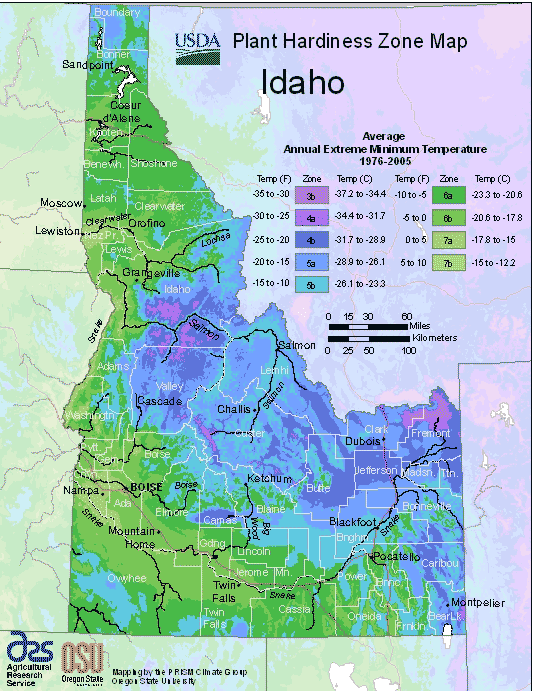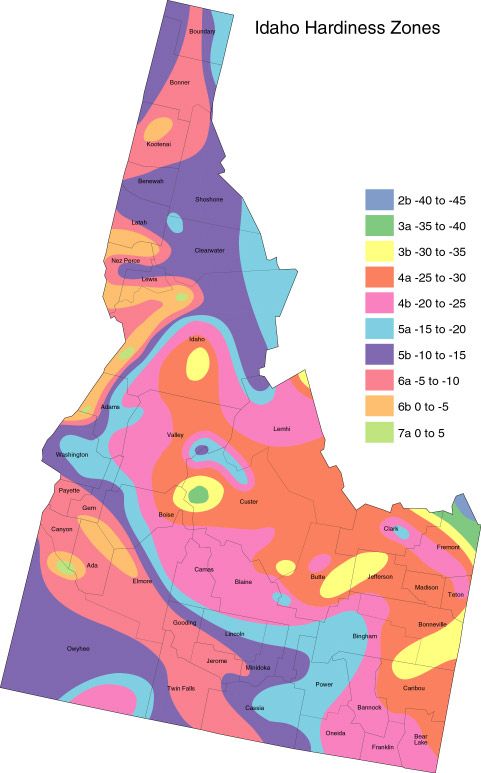
Table of Contents
Characteristics of Idaho Planting Region
- cold winters,
- hot summers,
- low humidity,
- wide diurnal temperature range.
Idaho’s environment for growing includes cold winters, hot summers, low humidity, and a great difference between day and night temperatures.
Most of the nation can expect warm-to-hot summers with plenty of sunshine. Nonetheless, the time between frosts varies widely across the region, so research the norm for your locality.
Challenges of Growing in Idaho
1. Diverse Climate
The diversity in landscape and weather throughout the state makes it difficult to create one hardiness measure. The USDA’s zones are a good place to begin, yet they can sometimes be misleading when planting in certain parts of the state.
2. Unpredictable Weather

3. High Elevation
Idaho is mostly situated at a high elevation, averaging around 5000 feet with different areas having different altitudes. This makes gardening difficult due to the varying winter minimum temperatures that occur with each elevation change.
Thriving in the Gem State: Best Plants for Idaho’s Planting Zone
Here are some of the best plants to grow in the Gem State:
- Idaho Blue-Eyed Grass (Sisyrinchium idahoense): This native perennial is well-suited to Idaho’s planting zone. Idaho Blue-Eyed Grass features delicate blue flowers with yellow centers that resemble tiny irises, adding a touch of color and charm to any garden.
- Western Red Cedar (Thuja plicata): A native evergreen tree, the Western Red Cedar is ideal for adding year-round greenery to landscapes. It thrives in the cooler climate of northern Idaho and offers a pleasant aroma that freshens the air.
- Shasta Daisy (Leucanthemum x superbum): Shasta Daisies are hardy perennials that thrive in Idaho’s planting zones. Their pure white petals and bright yellow centers create a classic and elegant look, making them popular in both formal and cottage-style gardens.
- Western Sand Cherry (Prunus besseyi): As a tough, drought-resistant shrub, the Western Sand Cherry is an excellent choice for Idaho gardens. It produces sweet, edible cherries and features beautiful white flowers in the spring.
- Black-Eyed Susan (Rudbeckia hirta): This bright and cheerful wildflower is perfect for adding a splash of color to any garden. Black-Eyed Susans thrive in the warm summers of Idaho and attract butterflies and bees with their nectar-rich blooms.
- Idaho Locust (Robinia x ambigua ‘Idahoensis’): This deciduous tree is well-adapted to the Idaho planting zone, boasting a graceful, weeping form. In spring, it produces fragrant, cascading clusters of white flowers that add a touch of elegance to the landscape.
- Russian Hawthorn (Crataegus ambigua): Russian Hawthorn is a tough and adaptable tree for Idaho’s climate. It features clusters of small white flowers in the spring and striking red berries in the fall, providing year-round interest.
- Purple Coneflower (Echinacea purpurea): As a hardy perennial, Purple Coneflower thrives in Idaho’s planting zone and attracts a wide range of pollinators. Its distinctive pink-purple flowers add a splash of color to any garden bed or wildflower meadow.
- Siberian Iris (Iris sibirica): This elegant perennial thrives in the moist soils of Idaho’s cooler regions. Siberian Iris produces delicate, colorful blooms that add a touch of grace and beauty to water features and borders.
- Idaho Fescue (Festuca idahoensis): As a native grass, Idaho Fescue is well-adapted to the state’s planting zone. It offers fine-textured, blue-green foliage that remains attractive throughout the year and requires minimal maintenance.
To ensure successful gardening in Idaho, it’s essential to consider the region’s varying climates, elevation, and soil conditions. For colder regions, it’s crucial to choose cold-hardy plants that can withstand freezing temperatures and snow. On the other hand, in warmer regions, drought-tolerant plants that can endure hot, dry summers are more suitable.
Proper watering, mulching, and fertilization are crucial for promoting healthy plant growth and ensuring their resilience to Idaho’s climate. Additionally, gardeners should take advantage of the state’s native plants, which are naturally adapted to local conditions and provide essential habitat and food for native wildlife.
In conclusion, Idaho’s planting zones (Zone 4 and Zone 5) offer an exciting array of plants that can thrive in the state’s diverse environments. Whether it’s native perennials, hardy trees, or colorful wildflowers, the best plants for Idaho will enhance the beauty of gardens and landscapes while harmonizing with the natural splendor of the Gem State. By choosing the right plants and providing proper care, gardeners can create stunning and sustainable gardens that flourish throughout the seasons.
